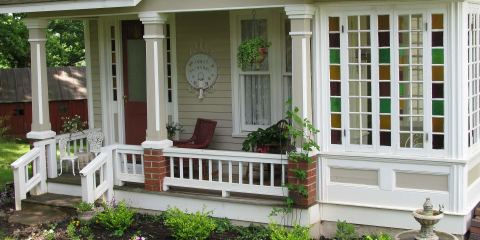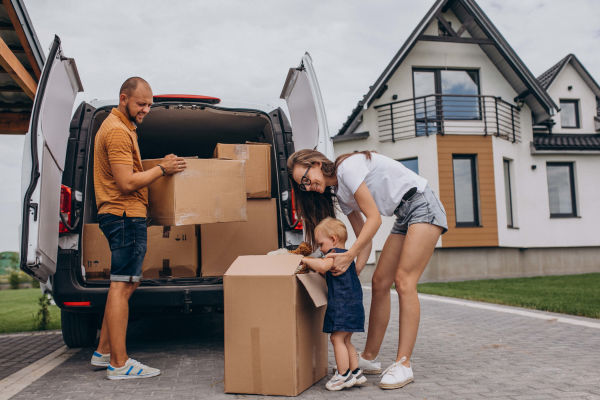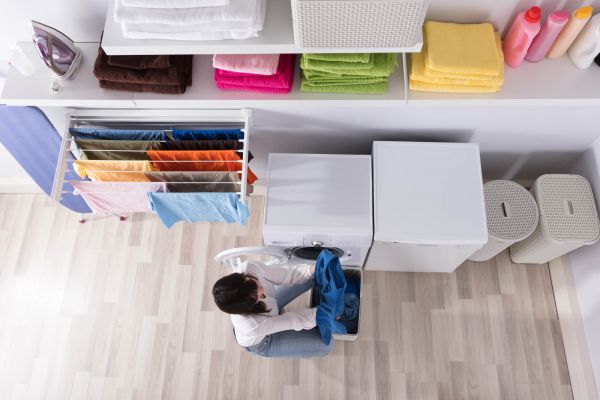Could you live in a 200 square foot house? Yes, you read that right—a 200 square foot house. The typical American home is around 2,600 square feet, but many people are trading in their spacious digs for a smaller alternative—the tiny house.
HGTV defines a tiny house as anything smaller than 600 feet, but many of these structures are built on trailer beds and are actually much smaller. The average tiny house is only 186 square feet, but they typically range anywhere from about 100-400 square feet.
Condensing 2,600 square feet into roughly 200 takes some serious decluttering, but there are many advantages to such a drastic downsizing. To help shed some light on the tiny house movement, we reached out to enthusiasts and tiny house builders across the country for their insights into why tiny houses are so popular, tiny house organization ideas, and how to downsize for your move. We asked them three questions:
- What are some of the most common reasons people have for moving into a tiny house?
- Do you have any tips for organizing a tiny house or tiny house storage hacks to make the most of limited space?
- Are there any items people should always keep, or always toss (or donate) when decluttering before moving into a tiny house?
Here’s what they had to say:
1. What are some of the most common reasons people have for moving into a tiny house?
People cite many reasons for making the choice to downsize into a tiny house. Adopting a minimalist lifestyle, saving money, and reducing environmental impact are the most common:

Marcus Stoltzfus, Liberation Tiny Homes
“Downsizing, minimalist lifestyles, and saving money are all big reasons. The more that our nation becomes transient in nature, we will embrace tiny living even more.”

Jason Francis, Tiny Heirloom
“The most common reason our clients move into a tiny home is to declutter their lives. Whether that be from possessions or financial burdens or both, the effect is the same—more freedom and a less stressful life. Probably right behind that is a vacation home or nightly hospitality on platforms like Airbnb.”

Nick Pereyra, Tiny Mountain Houses
“The reasons often vary by lifestyle. A lot of the younger buyers are seeking financial freedom and the appeal of not being tied to one location to live in. Our more mature buyers are often looking to downsize in order to simplify things and focus on things in their life other than material belongings. We also have a lot of environmentally-friendly consumers who are drawn to the smaller, more eco-friendly footprint.”
The environmental impact of tiny housesAccording to inspectamerica.com, the typical house is wired to use between 100 and 200 amps, but tiny houses can be powered in as few as 20 amps or less. Many are even designed to live “off grid”, which means they can be entirely disconnected from water and electricity for short periods of time. Tiny houses also often take advantage of alternative sources of power such as wind or solar, as well as other environmentally friendly appliances such as rainwater catches, filtration systems, and even composting toilets. |

Tom Bastek, Tiny Home Builders
“Normally, it is one of three things. One, they want to simplify their life. Two, they are looking at saving money. Or three, they are looking to help save the planet. I feel that the majority fall into the first two, and the third is really a benefit of doing them.”

Sharon Read, Seattle Tiny Homes
“Financial issues—today's costs for purchasing a traditional home are skyrocketing. Many young people cannot afford it.”
Money mattersTiny houses are significantly cheaper than buying a full-sized detached home, or even renting an apartment in some parts of the country. As of April 2017, the average cost of a new home was $368,800. On the other hand, a tiny house can cost as little as $22,000 if you build it yourself. Hiring an engineer to design and build a tiny house will add to the cost, but it will still be cheaper than the cost of a standard detached home. |

Edward Winston, Tiny Spaces Living
“There are 3 common reasons why people make the move to a tiny house: They want to save money and time by reducing bills and spending less time on housework; they choose the frugal & minimal lifestyle; or they have a plan for their retirement and would like to use the savings for traveling in a tiny house.”
2. Do you have any tips for organizing a tiny house or tiny house storage hacks to make the most of limited space?
Decluttering, dual-functionality, and smart decor choices are key to organizing a tiny house. Read on for our experts’ tiny house organization ideas:

Marcus Stoltzfus
“Try to have almost everything in your home double its use, whether a kitchen cabinet pulls out and also becomes a drying rack for dishes or your couch also doubles as a bed. Make sure all you are using is necessities. Clothing is a big one for this—downsizing works well if you are comfortable wearing 5-10 t-shirts almost all the time. If it worked for Steve Jobs, it can work for you!”

Jason Francis
“Really think about each space and what its primary purpose is. Once you home in on that and design it to best serve that purpose, then add in some multipurpose, like fold-out or drop-down tables, hidden TVs, Murphy beds, extra storage, etc.. Every space should have a primary and secondary purpose (bonus points if you can get a third purpose in a space!)”

Nick Pereyra
“Take note of what you use on a daily basis and try to simplify gradually as opposed to all at once. In some cases, it can be helpful to get a moving box and fill it with essential items to see how long you can go with only using items from the box—some items may not be as essential as previously thought. Another big thing is multi-faceted or convertible tools and furnishings. Things like a hide-a-bed that can also be used as a desk during the day, as well as fold-flat stools that can be stored away when not in use.”

Tom Bastek
“Look at where you like to spend the majority of time in your large home, and then make that the focus of your tiny home. If you like to cook, spend more space on the kitchen, etc.”

Sharon Read
“Get a professional to look over your plans, even if you aren't having them build your tiny house. Tiny house builders have a wealth of experience that you might not have, even after doing a lot of research.”

Edward Winston
- “Use light colors for the house's theme. I recommend white
- Choose simple furniture
- Opt for large windows to make the house look spacious. A big window also helps you get more sunlight, which will make the room brighter
- Multifunctional furniture and compact appliances will help you save more space
- Don't use doors to divide rooms in your tiny house (except the bathroom, of course). Dividing rooms in a tiny house only makes it look smaller.”
|
Tiny House Storage Hack: Make the most of vertical space. Hang difficult to store items such as pots and pans on hooks, and install shelves near your ceiling or above doors. In addition to providing more space for storage, utilizing vertical space draws the eye upward, which can make your space seem larger. Open shelving can also draw the eye upward, but it can appear cluttered if you have too much stuff or if your stuff is disorganized. |
3. Are there any items people should always keep, or always toss (or donate) when decluttering before moving into a tiny house?
There are no hard and fast rules for what to keep and what to toss when you’re downsizing ahead of your move to a tiny house. Ultimately, what you should hold on to and what you shouldn’t will depend on your lifestyle and your needs.

Marcus Stoltzfus
“Keep: skillet, silverware, cup, coffee mug, phone, computer, Kindle, bath towels, one pair of shoes, one pair of boots or rain boots, a throw blanket, pillow, and a chair for the outdoors. Create a memory box that has items for remembrance.
Toss: extra shoes, extra clothes and excess furniture. It might also be a good time to see if you really need those kindergarten report cards that you’ve been dragging around from house to house.”

Jason Francis
“I think this really comes down to the individual. Each of us has our own personality, likes and dislikes, habits, hobbies, needs and wants. We always encourage people to look at what they have, and if it brings them joy, keep it. If its brings them false or temporary happiness, or if they haven't used it in over 3 months then you probably don't need it.”

Nick Pereyra
“It really depends on the person. Some people have heirlooms or sentimental pieces they’d like to hold on to, and on occasion, we have to modify a space to allow for certain things. Pets are also very important; we have made more custom things to accommodate pets than I can count. Clothes are often a big item that most people have to cut down on quite a bit, and I often see people downsizing things like TVs and computers because they fit better into the smaller space.”

Tom Bastek
“Yes, they should throw out EVERYTHING! No, I am kidding. That is a common misconception, though. You do not have to get rid of everything. But you do need to keep in mind that if you are moving down to 1/10th the amount of space, then you are realistically going to have 1/10th the amount of stuff.”

Sharon Read
“Anything you haven't used in the past 6 months!"
|
TSI Tip: Hold onto items that can pull double- or triple-duty. Toss anything you don’t use, anything you might use, things you used to use, or things you want to use. Eliminate multiples, and give serious thought to ditching single-use bathroom or kitchen appliances like your pasta maker or waffle iron. |
Ready to Downsize?
Sold on the tiny house lifestyle? The sooner you start decluttering, the better. When you’re ready to move into your tiny house, give our home downsizing and small move specialists a call! We can help you ship your belongings to your new digs so you can get settled into your simplified lifestyle.
Meet the Contributors

Marcus Stoltzfus is VP of Sales & Marketing for Liberation Tiny Homes. His marketing background of building several other companies came into play when we asked him to be a part of our team. He is a resident of Lancaster, PA and is a big part of the tiny house movement in PA.

Tom Bastek is the Director of Marketing for Tiny Home Builders and has been on the tiny bandwagon for years. He has built two tiny homes in his time with Tiny Home Builders. He authors most of the articles in the Tiny Home Builders blog. In his spare time he enjoys improv comedy acting, pinball, LEGO building, bowling, craft beer and the New York Jets. He resides in Atlanta with his wife and his hound Josie, who takes up most of the bed. You can reach him at tom@tinyhomebulders.com.

Born and raised in Portland, Oregon, Jason Francis grew up on construction sites with his brother Zach while their dad, a 35+ year general contractor and builder, taught them all the tricks of the trades. On a 10 month long sailing trip from San Diego, CA to Brisbane, Australia, Jason and Zach learned the art of small simplified living, as well as what truly makes any space a home. After returning from Australia, the brothers started their first business building residential housing. In between a few projects, they decided to build their first tiny home with their brother-in-law Tyson Spiess. What started out as a small summer project in Jason’s garage exploded into what the world now knows as Tiny Heirloom.

Nick Pereyra graduated from Oregon State University in 2015 with a degree in Entrepreneurship from the college of business and a minor in multimedia communications. Upon graduating, Nick had the opportunity to be a founding member of Tiny Mountain Houses along with his brother (Ryan) and father (Lou), as well as boundless encouragement from his Grandfather (Manuel). Nick enjoys finding new ways to making tiny living easier and more comfortable for anyone open to living smaller. In his free time, Nick enjoys the great outdoors including everything from hiking to snowboarding. He enjoys finding creative solutions and knows there is no singular approach to tiny houses.

At age 12, Sharon Read was drawing floor plans for homes that she proudly labeled as “bare minimum design.” She didn’t like wasted space and wanted every square inch to count! Then in 2010, as America struggled to recover from the glut of unsold mini-mansions, Sharon realized tiny homes were the future. She recognized that people want to live simply without stressing the environment. She stopped building regular houses and launched Seattle Tiny Homes to provide highly efficient designs for people who care about quality. Since then, Seattle Tiny Homes has become the first tiny home company in the USA to achieve certification as an RV (recreational vehicle) manufacturer and dealership of tiny home RVs.

Edward Winston is the Founder of TinySpacesLiving.com. Many years ago, he found his passion for tiny living spaces like the tiny house, RV, container home, etc. He started to research and learn more about it, including ways to build and organize, as well as tips on living in a small space home.




